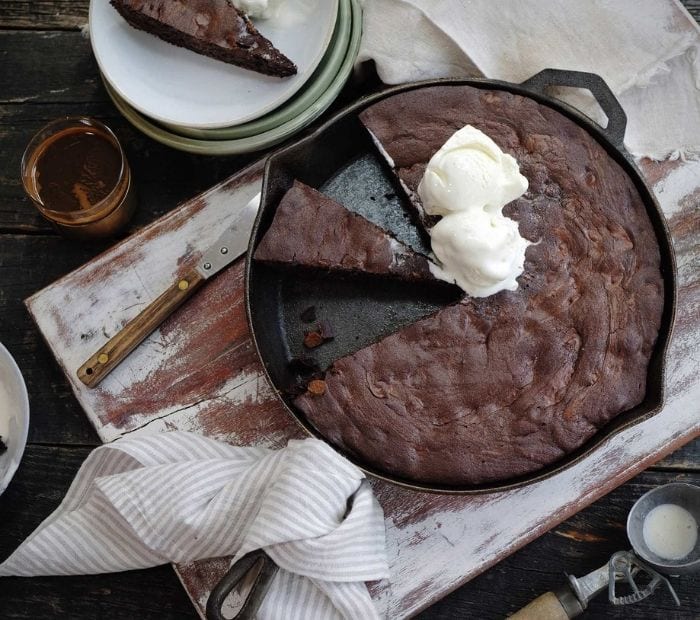-
-
Pre-seasoning.
“Seasoning” of cast iron is the natural coating that happens when oil hardens into and onto the pan. The more you use it, the better it gets. Frequent use and the right seasoning are what gives skillets their non-stick qualities and unique flavour. If you’re new to the world of cast iron cookware, the first and most crucial step is called ‘Pre-Seasoning.’ It takes a little time, but you only have to do it once. And what’s a little prep-time for 100 years of joy? Give it a good scrub with mild dish soap and hot water, dry it well, and place it in a warm oven (100°C) for ten minutes. Remove and coat the entire surface with a very thin layer of grapeseed oil. Bake for another ten minutes at 180°C, before taking out to wipe away any excess oil. Return it to the oven, crank the heat to 220°C for an hour, leaving your pan in the oven to cool right down.
-
Steer clear of the dishwasher.
Rinse by hand with hot water, ideally when the skillet is still warm from cooking. If you get hard to remove food, use a cloth or soft brush. Don’t forget, heat will do a deeper clean than any harsh cleaning product.
-
Keep it dry.
Ensure you dry your skillet completely after cleaning. You may place it over a low heat on the stovetop for a minute or two to make sure that all the water has evaporated.
-
Oil it up.
Before returning the skillet to its bag, (or stove top to await the next cook up) apply a teaspoon of grapeseed oil to the entire surface with a cloth or paper towel. This protects the pan and stops it from drying or rusting. You may go for a light spray of olive oil – the flavour you choose is up to you.
- Keep the heat low to start with.
In the early life of a cast iron skillet, your food may stick a little. It is a good idea to be generous with your cooking oils and fats to build up a non-stick base. Keep the heat to low or medium as your initial layers of seasoning develop. Some dishes are better to break your skillet in with; caramelising onions or frying chicken. -
Avoid acidic or long simmered foods in the beginning.
Acidic foods like tomatoes, wine, citrus, and vinegar can eat away at the skillet’s seasoning. So, until your cast iron pan’s surface is better established, it’s best to avoid heavily tomato based sauces. You’ll know your skillet is broken-in when the layer of seasoning has become reliably non-stick. Then a little acid here and there isn’t an issue.
-
Go experimental.
Try out some of those amazing cast iron skillet recipe videos that are always popping up on Instagram and Facebook. Definitely get inspired and think beyond simply searing your steak in your skillet (though that is a delicious way to use it as well). Experiment with everything from brownies, cornbread, cobblers and cookies to fish pies, roast lamb and even pizza. Try it out on the stove top, in the oven, BBQ, camping fire, woodfired oven….but maybe not that bonfire.
-
Salt scrub.
A super easy way to maintain your cast iron cooking surface is to do a stove top salt clean. Put in about half a cup of coarse salt – enough to cover the cooking surface and turn up the heat, cooking it for about 5 minutes. Use a wooden spoon or spatula to rub the salt over the cooking surface, removing any stubborn stuck-on bits. Empty the salt and rub clean with a paper towel or dry cloth. Re-oil and it’s ready to roll. This is also a great way to neutralise flavours if you are going from cooking something spicy or fishy onto baking something sweet.
-
Buy Locally made.
Slash the air miles and support local Kiwi businesses by purchasing a cast iron skillet that is made right here in New Zealand. The Ironclad Pan Company is the original and only New Zealand made cast iron cookware company. The pans are hand-crafted in an Auckland foundry, using the highest grade recycled T100 iron. They also come with an unprecedented Three Generation Guarantee, protecting your cookware for the next 100 years.
-
Treat it with respect.
Cast iron cookware has its own special set of rules, but it will last a lifetime – or three – if you treat it right. It is also extremely versatile and durable. Cast iron skillets just get better with age. So, use it frequently and take good care of it. If you do, you’ll be passing it down for the next generation to enjoy.
-




